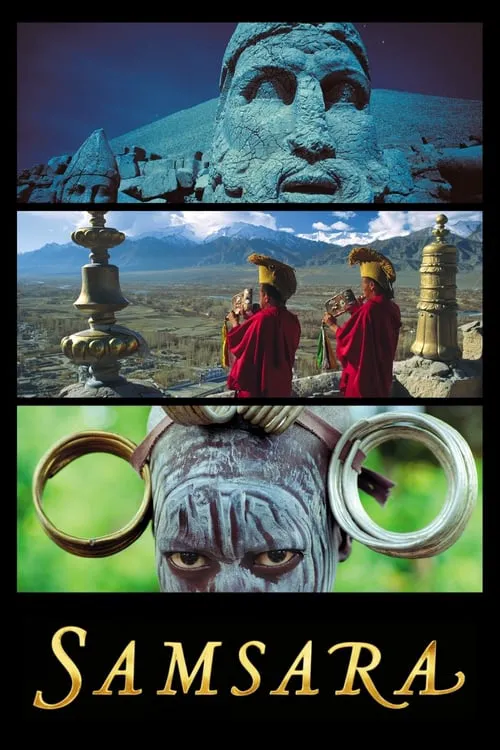Samsara

Plot
Samsara is a mesmerizing visual odyssey that delves into the complexities of human existence, exploring the intricate relationships between nature and humanity, as well as the profound effects of globalization on the world we inhabit. Filmed over five years in twenty-five different countries across five continents, and captured on the majestic seventy-millimetre film format, director Ron Fricke's magnum opus is an epic cinematic experience that transcends the boundaries of traditional documentary filmmaking. The film's narrative threads are woven from the disparate experiences of people from various walks of life, each inhabiting a unique cultural, geographical, or industrial landscape. Fricke's intention was to create a film that not only showcases the beauty and brutality of our planet but also exposes the interconnectedness of our world. In doing so, Samsara unfolds as a poignant commentary on the human condition, one that encourages the viewer to reflect on their place within the grand scheme of existence. Sacred Grounds The film opens with a stunning sequence of footage, capturing the intricate rituals of a Tibetan Buddhist monastery, juxtaposed with the rhythmic chanting of Hindu pilgrims at a revered sacred river in India. These powerful images set the tone for the subsequent exploration of the world's most revered and revered sites. Fricke documents the vibrant colors and sounds of these sacred grounds, often using long takes and deliberate pacing to convey the reverent atmosphere that pervades these hallowed places. Throughout the film, Fricke returns to these themes of spirituality and reverence, capturing the elaborate processions of devotees in Morocco's vibrant pilgrimage to the Souk Essakifa, and the ritualistic ceremonies that unfold within the ancient walls of Japan's sacred Fushimi Inari shrine. Each sequence serves as a testament to the enduring power of faith and the human desire to connect with the divine. Disaster Zones In stark contrast to the peaceful tranquility of the sacred grounds, Samsara exposes the world's most tragic and poignant devastation. Fricke's camera captures the ravaged landscapes of war-torn zones, where the relentless drumbeat of conflict has reduced entire communities to rubble and despair. The haunting aerial footage over a ravaged landscape in Rwanda serves as a poignant reminder of the atrocities that human conflict can unleash upon the world. Disaster zones are further exemplified by images of an abandoned city in Romania, once bustling with life but now eerily deserted, while a sequence set in a massive, sprawling refugee camp in Kenya serves as a sobering reminder of the human cost of displacement and displacement. These scenes convey the devastating impact that human conflict has on entire communities, as well as the displacement and suffering that can follow. Industrial Complexes While the sacred and war-torn zones represent the more abstract aspects of the human experience, the industrial complexes section provides a concrete examination of humanity's relationship with technology and industry. Fricke takes the viewer on a tour of massive infrastructure projects around the world, capturing the relentless pace and efficiency of globalized production. From the towering steel girders of China's high-speed railway system to the intricate dance of workers on the production lines of a massive electronics factory in South Korea, this section of the film conveys the frenetic energy of the modern industrial era. These sequences serve as a reflection of our society's relentless drive for growth and efficiency, and the impact that this relentless pursuit has on the natural world. Natural Wonders In stark contrast to the manufactured landscapes of the industrial complexes, Fricke turns to the breathtaking majesty of our planet's natural wonders. The film unfolds to the soaring mountains of Tibet's Himalayan peaks, and the vast expanses of Africa's Serengeti plains, teeming with life and bursting with vibrancy. We witness the awe-inspiring beauty of the majestic Grand Canyon, and the ethereal tranquility of a forest in the depths of the Amazonian rainforest. These moments provide a respite from the more jarring images of the war-torn and industrial zones, reminding us of the awe-inspiring power and beauty of our natural world. Fricke's masterful use of 70mm film format brings the viewer face-to-face with these natural wonders, capturing the intricate textures, and breathtaking vistas in exquisite detail. Throughout Samsara, Fricke asks fundamental questions about our place within the world, and the consequences of our actions on the planet. By juxtaposing humanity's most revered sites with some of the world's most tragic and industrialized landscapes, the film offers a thought-provoking reflection on the human condition. As we gaze out at the world's beauty and brutality, Samsara invites the viewer to ponder the interconnectedness of our world, and our responsibility to preserve the delicate balance between nature and humanity.
Reviews
Recommendations




